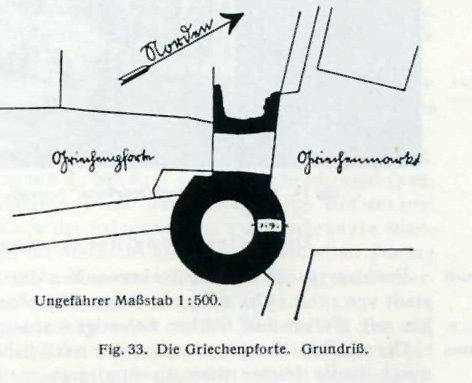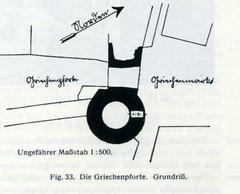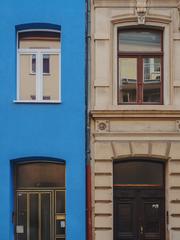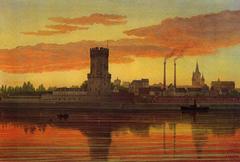
Altstadt-Süd Cologne: Visiting Hours, Tickets, and Historical Sites Guide
Date: 15/06/2025
Introduction
Altstadt-Süd, set along the picturesque Rhine River, is one of Cologne’s most historically significant and culturally dynamic districts. From its Roman origins as Colonia Claudia Ara Agrippinensium, through medieval growth and post-war reconstruction, to its present-day urban vibrancy, Altstadt-Süd offers an immersive journey through time. Visitors will discover Roman archaeological remains, grand medieval churches, iconic landmarks like the Cologne Cathedral, and a thriving scene of Kölsch breweries and festivals. This guide presents comprehensive information on historical sites, visiting hours, ticketing, accessibility, transportation, and insider travel tips, ensuring you experience the best of Altstadt-Süd. (de.wikipedia.org, nomadicmatt.com, travelsetu.com)
Table of Contents
- Introduction
- Roman Foundations and Early Development
- Medieval Expansion and Religious Significance
- Urban Structure and the Kölsch Veedel
- Industrialization and Urban Change
- Destruction and Reconstruction in the 20th Century
- Contemporary Urban Landscape and Cultural Heritage
- Visiting Altstadt-Süd: Hours, Tickets, and Travel Tips
- Unique Experiences: Tours, Events, and Photo Spots
- Visual and Interactive Resources
- FAQs
- Conclusion & Call to Action
- References
Roman Foundations and Early Development
Altstadt-Süd’s origins trace back to Roman times, when Cologne was founded as Colonia Claudia Ara Agrippinensium in 50 CE. The district holds archaeological treasures, such as the remains of the Praetorium, ancient city walls, roads, and impressive Roman engineering like sewage systems. The Archaeological Zone reveals the sophistication of Roman urban planning and provides a tangible link to Cologne’s earliest days (history-timeline.net, planetware.com).
Medieval Expansion and Religious Significance
During the Middle Ages, Altstadt-Süd thrived as a hub of trade and religion. The district was fortified with city walls (1180–1259), remnants of which—including the Severinstorburg and Bayenturm gates—still stand today. Great St. Martin Church, a Romanesque masterpiece, and the historic City Hall, with its 900-year history, highlight the area’s religious and civic prominence (de.wikipedia.org).
Urban Structure and the Kölsch Veedel
Altstadt-Süd and Altstadt-Nord form Cologne’s historic core, divided into distinct neighborhoods or “Veedel,” each with its own identity. The Ost-West-Achse, including Pipinstraße and Neumarkt, separates Altstadt-Süd from Altstadt-Nord, while the Kölner Ringe boulevards mark the boundary with the Neustadt. This structure preserves the district’s local character and facilitates exploration (de.wikipedia.org).
Industrialization and Urban Change
Industrialization in the 19th century brought limited change to Altstadt-Süd, largely due to its dense medieval layout. Notable exceptions include the Stollwerck chocolate factory in Severinsviertel. Administrative adjustments separated Altstadt-Süd from Altstadt-Nord, allowing for more effective management of growth and modernization (de.wikipedia.org).
Destruction and Reconstruction in the 20th Century
World War II devastated much of Altstadt-Süd, but post-war reconstruction restored many of its historical buildings using traditional methods. Today, the district’s authentic streetscapes and landmark buildings reflect both resilience and reverence for Cologne’s past (travelsetu.com).
Contemporary Urban Landscape and Cultural Heritage
Modern Altstadt-Süd is a vibrant area where history meets creativity. The district is renowned for its lively squares, Kölsch breweries, art galleries, and annual events like the Cologne Carnival. Key sites include the Severinstorburg gate, Bayenturm tower, and Nord-Süd-Fahrt thoroughfare—which, despite dividing some neighborhoods, could not diminish the strong Veedel spirit celebrated in local festivals. Visitors enjoy a unique blend of tradition and innovation throughout the area (de.wikipedia.org).
Visiting Altstadt-Süd: Hours, Tickets, and Travel Tips
Major Sites and Museums:
- Cologne Cathedral (Kölner Dom): Open daily 6:00 AM–7:30 PM; free entry to the nave, €6 for tower climb (moonhoneytravel.com)
- Great St. Martin Church: Open daily 9:00 AM–6:00 PM; free entry (nomadicmatt.com)
- Wallraf-Richartz Museum: Tue–Sun 10:00 AM–6:00 PM; €10–12 admission, combined tickets available
- Museum Ludwig: Tue–Sun 10:00 AM–6:00 PM; approx. €11
- Roman-Germanic Museum: Tue–Sun 10:00 AM–6:00 PM; €6
- Imhoff-Schokoladenmuseum (Lindt Chocolate Museum): Daily 10:00 AM–6:00 PM; €13 (schokoladenmuseum.de)
- Rautenstrauch-Joest-Museum: Tue–Sun 10:00 AM–6:00 PM; €8
- Mustard Museum: Tue–Sat 10:00 AM–5:00 PM; free entry
Accessibility: Most major sites are wheelchair accessible, though some historic buildings have limited access. Always check ahead for specific needs.
Transportation: The district is served by tram, bus, and U-Bahn, with Neumarkt and Heumarkt as main hubs. Walking and biking are ideal for exploring cobblestone streets and riverside promenades.
Tickets and Passes: Save with the Cologne Welcome Card or KölnCard, offering discounts and free public transport.
Best Time to Visit: Spring and autumn feature mild weather and fewer crowds; November–December is festive with Christmas markets.
Unique Experiences: Tours, Events, and Photo Spots
- Guided Tours: Explore Roman ruins, medieval churches, breweries, or contemporary art with specialized walking or cycling tours (Germany Travel Blog)
- Festivals: Cologne Carnival (February/March), Christmas Markets (late November–December), and summer concerts enliven the district (Evendo)
- Photo Hotspots: Rhine promenade at sunset, Severinstorburg illuminated at night, vibrant murals, and historic facades
Visual and Interactive Resources
Enhance your visit with interactive maps, virtual tours, and augmented reality apps from Cologne’s official tourism sites. The Audiala app provides personalized walking tours, event updates, and exclusive ticket discounts.
Frequently Asked Questions (FAQ)
Q: Are there combined tickets or museum passes?
A: Yes, the Cologne Welcome Card and museum passes offer entry to multiple sites and discounts.
Q: Is Altstadt-Süd family-friendly?
A: Absolutely. Parks, museums, and interactive exhibits are suitable for all ages.
Q: Are guided tours available in English?
A: Yes, many tours offer English and German options.
Q: Does the district offer accessible transport and attractions?
A: Most major sites and public transport are accessible, though some historic areas may be challenging.
Q: When is the best time to visit Altstadt-Süd?
A: Spring and autumn for pleasant weather; winter for festive markets.
Practical Essentials
- Safety: The district is generally safe; guard against pickpockets in crowded areas.
- Language: German is official, but English is widely understood in tourist areas.
- Currency: Euro (€); credit cards accepted, though cash is still common in smaller cafés.
- Local Etiquette: Place your coaster on your Kölsch glass to stop refills; greet with “Hallo” or “Guten Tag.”
- Wi-Fi: Available in most hotels, cafés, and public spaces.
Accommodation Tips
Altstadt-Süd offers a range of accommodations, from budget hostels to boutique hotels like NH Köln Altstadt and art’otel cologne, both convenient to major sites and public transit (Travel Hotel Expert). Book early during festivals.
Shopping and Dining
- Schildergasse: Major shopping street with international and local brands (The Broke Backpacker)
- Local Cuisine: Try Himmel un Ääd, Rheinischer Sauerbraten, and Kölsch beer in traditional breweries or riverside cafés.
Sample Itinerary
Classic Day:
Morning: Rhine stroll, Chocolate Museum visit
Midday: Rautenstrauch-Joest-Museum or Basilica of St. Severin
Afternoon: Lunch at a brewery, shopping on Schildergasse
Evening: Riverside café or guided tour
Connectivity to Other Districts
Altstadt-Süd is centrally located, making it easy to explore the Belgian Quarter for nightlife, Altstadt-Nord for the cathedral, or Deutz across the Rhine for city views.
Conclusion
Altstadt-Süd is a vibrant testament to Cologne’s rich heritage—where Roman roots, medieval grandeur, and modern creativity converge. With accessible transportation, family-friendly sites, renowned museums, lively squares, and culinary delights, the district promises a rewarding experience for every traveler. Make the most of your visit by planning ahead, using digital resources, and embracing local traditions. Download the Audiala app, check official tourism sites, and start your exploration of Cologne’s living history today.
For more travel tips and the latest updates, download the Audiala app and follow our social media channels. Happy travels!
References
- de.wikipedia.org
- nomadicmatt.com
- travelsetu.com
- history-timeline.net
- planetware.com
- Evendo
- Germany Travel Blog
- Know Germany
- schokoladenmuseum.de
- Travel Hotel Expert
- Miss Tourist
- The Broke Backpacker
- moonhoneytravel.com








































































